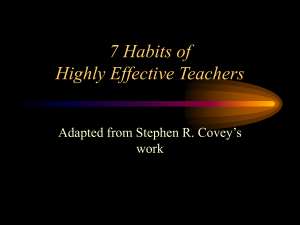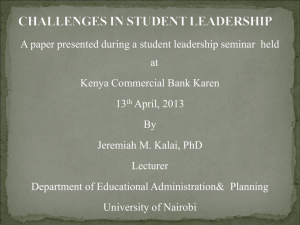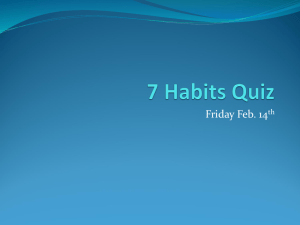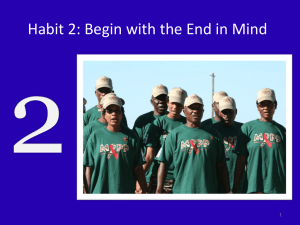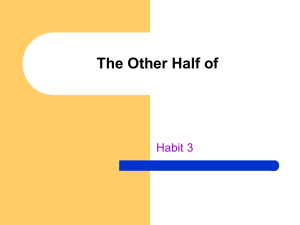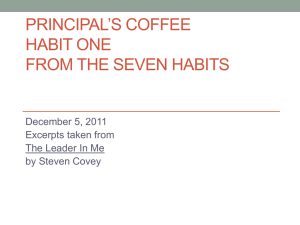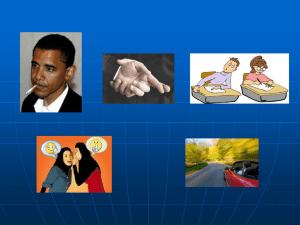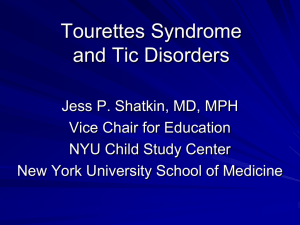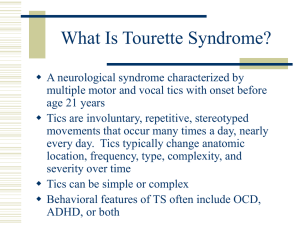Treatment of Habit or Tic Disorders
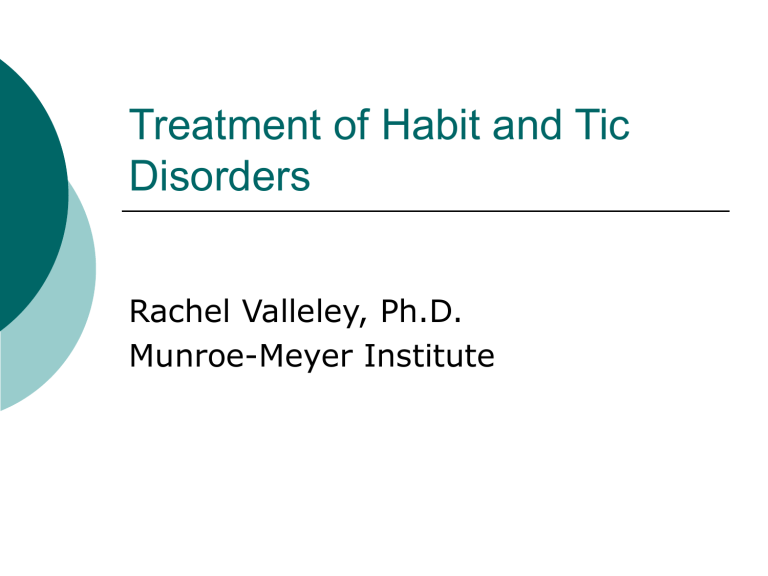
Treatment of Habit and Tic
Disorders
Rachel Valleley, Ph.D.
Munroe-Meyer Institute
Overview
Habits vs. Tics
DSM Criteria
Assessment
Treatment options:
Medication
Habit Reversal
Case Example
Habits
“frequent, repetitive behaviors that cannot be explained by physiological causes and appear to serve no identifiable physiological function”
Examples: nail biting, nail picking, trichotillomania, thumb sucking, hair twirling
Tics
“sudden, brief, involuntary, rapid, nonrhythmic, repetitive movements or utterances that are purposeless and stereotypic”
Examples: eye blinking, facial grimacing, shoulder shrugging, throat clearing, coughing, growling, sniffing
DSM Diagnoses
Habits:
Stereotypic Movement Disorder
Trichotillomania
Tics:
Transient tic disorder
Chronic motor or vocal tic disorder
Tourette’s disorder
Habits
Stereotypic Movement Disorder
Trichotillomania
Stereotypic Movement Disorder
Repetitive, seemingly driven, & nonfunctional motor behavior
Interferes with normal activities or results in self-inflicted bodily injury
Not accounted for by other disorders
(e.g., OCD, tics, trichotillomania)
Not due to substance or general medical condition
Lasts longer than 4 weeks
Trichotillomania
Recurrent pulling out of one’s hair, resulting in noticeable hair loss
Sense of tension immediately before pulling out the hair or resisting the behavior
Pleasure, gratification, or relief when pulling out hair
Not better accounted for by other disorder or medical condition
Causes clinically significant distress or impairment
Demographics of Trichotillomania
Prevalence: 0.6%
Non-clinical hair pulling (10-13%)
Age of Onset: 13.1 yrs
More frequent in females
Onset if often precipitated by stressful life event (e.g., divorce, loss, academic pressures)
Scalp (80.6%)
Brow
(43.5%)
Lash
(47.3%)
Hair Pulling Episodes
Touching, manipulating region before pull
Can range from brief sessions with only a few hairs lost to sessions lasting several hours with hundreds of hairs pulled
Occurs in solitude but children do in front of family
Increased pulling during periods of stress, relaxation, or distraction
May be unaware they are pulling their hair and thus do not experience tension or relief
More often use dominant hand for pulling
Consequences of Hair Pulling
Post pull: play with hair
Result in total absence of hair, bald spots, or thinning of hair
Most serious consequence occurs when patients eat the hair and form hairballs in the stomach. Results in all kinds of complications like anemia, loss of appetite, nausea, vomiting
Comorbid Conditions
Most Common
Anxiety
Mood disorders
OCD: Some speculation that it is related to OCD
Tic Disorders
Transient tic disorder
Chronic motor or vocal tic disorder
Tourette’s disorder
Transient tic disorder
Single or multiple motor &/or vocal tics
Occur many times a day, nearly every day for at least 4 weeks but not longer than 12 consecutive months
Causes marked distress or impairment
Onset prior to 18
Not due to substance/medical condition
Do not meet criteria for other tic disorder
Chronic motor or vocal tic disorder
Single or multiple motor OR vocal tics but not both
Occur many times a day, nearly every day or intermittently for over 1 year, no more than 3 consecutive months tic free
Causes marked distress or impairment
Onset prior to 18
Not due to substance or medical condition
Do not meet criteria for Tourette’s
Tourette’s disorder
Both multiple motor & one or more vocal tics have been present but do not have to be at same time
Occur many times a day (usually in bouts), nearly every day or intermittently for over 1 year, no more than 3 consecutive months tic free
Causes marked distress or impairment
Onset prior to 18
Not due to substance or medical condition
Impairment from Habit or Tic
Common impairments/distress
Physical
Social
What causes or maintains habits/tics?
Physical Trauma
Automatic reinforcement
Positive
Negative
Social reinforcement
Very limited data on functional analysis of habits and tics
Mechanisms involved in
Trichotillomania
Negative reinforcement
Tension
Arousal reduction
Negative affective states
Automatic reinforcement
Sedentary (watching TV, getting ready for bed)
Contemplative (homework, reading)
Assessment Considerations
Rule out medical problem
Comorbid condition or habit?
Distress or impairment?
Observation
Self-monitoring
Permanent products
High probability situations
Ratings scales available
Empirically Supported Treatments
Medication
Haldol
Pimozide
Clonidine
Anafranil & Prozac for Trichotillomania
Behavioral Procedures
Habit Reversal
Medication
Haldol:
Tourette’s
Relieves symptoms up to 70-80% of patients.
Short term side effects
Long Term side effects
Pimozide
Clonidine
Behavioral Procedures
Massed negative practice
Punishment
Reinforcement
Relaxation Training
Function-Based Treatments
Habit Reversal
Massed negative practice
Requires the individual to perform each tic accurately & effortfully for a specified amount of time
Punishment
Time out
Trichotillomania
Topical creams
Sensory Extinction: e.g., gloves
Increasing effort: e.g., wrist weights
Reinforcement
Differential reinforcement of other behaviors or differential reinforcement of alternative behaviors
Relaxation Training
Reducing tension before the occurrence of tics
No data to support as sole treatment for tics
Function-Based Treatments
Determining the function of the tic to tailor treatment.
Is the tic occurring to escape something aversive or
due to social attention provided, or is it occurring due to the sensory stimulation provided?
“Complete Habit Reversal”
Originally developed by Arin & Nunn
(1973)
Consisted of 10-13 steps components
Simplified Habit Reversal: only 4 components necessary
90-100% reduction of tics that maintained over 12 months
Has been found effective for many types of habits and tics
Simplified Habit Reversal
Awareness Training
Competing Response Training
Relaxation Training (optional)
Social Support
Awareness Training
Increase awareness of when habit is occurring by:
Practice habit/tic in front of mirror
Focus on how muscles/body feels while engaging in habit
Have child identify times when habit occurs
Prompt child when habit occurred
Keep data on habit occurrence
Competing Response Training
Teach an incompatible behavior for when habit occurs
Select competing response
Practice competing response in front of mirror
Use competing response when urge for habit occurs
Use competing response in situations when habit is likely to occur
After habit occurs, practice competing response for one minute
Relaxation Training
(optional)
Reduce stress or anxiety if related to habit
Practice daily
Options
Progressive muscle relaxation
Visual imagery
Breathing exercises
Social support
Parents provide feedback and encourage child to use habit reversal procedure
Provide feedback to child to become aware of habit occurrence
Encourage competing response
Add reinforcement procedure if necessary
Reinforcement
Parents could reinforce:
Awareness training practices
Use of the competing response
Habit free periods of time
Case Example
11 year-old, 5 th grade Caucasian male
Tourette’s Disorder
Special Education for LD in Written
Expression
Motor Habit: Tensing face, pulling arms up, anticipation antecedent
Vocal Habit: ‘ah’ added between words, occurred both in conversation & oral reading
Assessment of Motor Tic
Interview of parent and child
Description of tic, duration, frequency
Situations more likely to do it in
Awareness?
Parent response
Parent, Teacher Observation
Videotape at home
Treatment of Motor Tic
Habit Reversal
Awareness
Watching videotape of self in session
Incompatible behavior
Social Support
Reinforcement for practices
Assessment of Vocal Habit
Assessment involved:
Determining instructional reading level
(5 th grade, 91-106 WPM & 95%
Comprehension)
Determining base rate of vocal habit while reading (28-29 VHM)
Sampling conversation (13 VHM)
Conducting a Brief Reading
Experimental Analysis
Brief Experimental Reading Analysis
Baseline conditions alternated with treatment conditions
Repeated Reading
Listening Passage Previewing
Word Error Correction
Reinforcement
Phrase Error Correction
30
25
20
15
40
35
10
5
0
Brief Experimental Reading Analysis
Intervention
Phrase error correction chosen as intervention
Mother trained
Home reading practices (10-20 minutes of preferred reading & one minute generalization probe) conducted over 2 months
Reading sessions recorded for reliability & treatment integrity
Tokens earned for participation
30
25
20
15
10
5
0
1
Results: Pre Integrity Feedback
2 3 4 5 6
Home Reading Sessions
7
In Session Probe
8 9 10
Integrity Data: Pre-Feedback
60%
50%
40%
30%
20%
10%
0%
100%
90%
80%
70%
June 19th June 27th June 28th
20
25
30
Results
Hom e Reading Generalization Probes: Pre
Integrity Check
Hom e Reading Generalization Probes After In Session
Integrity Check
In Session
Follow up
15
10
5
0
1 2 3 4 5 6 7 8 9 10 11 12 13 14 15 16 17 18 19 20 21 22 23 24 25
Hom e Reading Sessions
Results: Integrity data
70%
60%
50%
40%
30%
20%
10%
0%
100%
90%
80%
June 19th
Pre feedback
June 27th June 28th
Post feedback significantly few er habits in session
(5)
July 23rd July 24th
Integrity session checks
July 26th July 29th July 30th
Results
Decreased rate of oral habit from 28 per minute to 0-1 per minute while reading
Did not impact reading fluency (109
WPM at two month follow up)
Generalized to conversation speech
(13 to 1 per minute)
Discussion
Vocal habit conceptualized as dysfluency
PEC intervention resembles awareness training and practice of competing response
Important to collect treatment integrity data
Parents can be trained to conduct these types of interventions & collect data for reliability & treatment integrity
References
Christopherson, E. R., & Mortweet, S. L.
(2001). Treatments that work with children:
Empirically supported strategies for managing childhood problems. Washington, DC: American
Psychological Association
Glaros, A. G., & Epkins, C. C. (1995). Habit
Disorders: Bruxism, Trichotillomania, and Tics.
In M.C Roberts (Ed.), Handbook of Pediatric
Psychology (2 nd ed., pp.558-574). New York:
The Guilford Press.
Miltenberger, R. G., Fuqua, R. W., & Woods, D.
W. (1998). Applying behavior analysis to clinical problems: Review and analysis of habit reversal. JABA, 31, 447-469.
References
Valleley, R. J., Shriver, M. D., & Rozema,
S. (2005). Using brief experimental assessment of reading interventions for identification and treatment of a vocal habit. Journal of Applied Behavior
Analysis, 38, 129-133
Woods D. W., Miltenberger, R. G.
(2001). Tic Disorders, Trichotillomania, and othr repetitive behavior disorders.
Norwell, MA: Kluwer Academic
Publishers
